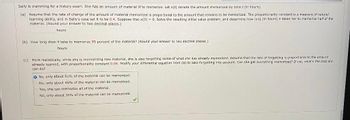
Advanced Engineering Mathematics
10th Edition
ISBN: 9780470458365
Author: Erwin Kreyszig
Publisher: Wiley, John & Sons, Incorporated
expand_more
expand_more
format_list_bulleted
Question

Transcribed Image Text:Sally is cramming for a history exam. She has an amount of material M to memorize. Let x(t) denote the amount memorized by time (in hours).
(a) Assume that the rate of change of the amount of material memorized is proportional to the amount that remains to be memorized. The proportionality constant is a measure of natural
learning ability, and in Sally's case set it to be 0.4. Suppose that x(0) = 0. Solve the resulting initial value problem, and determine how long (in hours) it takes her to memorize half of the
material. (Round your answer to two decimal places.)
hours
(b) How long does it take to memorize 95 percent of the material? (Round your answer to two decimal places.)
hours.
(c) More realistically, while she is memorizing new material, she is also forgetting some of what she has already memorized. Assume that the rate of forgetting is proportional to the amount.
already learned, with proportionality constant 0.04. Modify your differential equation from (a) to take forgetting into account. Can she get everything memorized? If not, what's the best she
can do?
O No, only about 91% of the material can be memorized.
No, only about 45% of the material can be memorized.
Yes, she can memorize all of the material.
No, only about 30% of the material can be memorized.
Expert Solution
This question has been solved!
Explore an expertly crafted, step-by-step solution for a thorough understanding of key concepts.
This is a popular solution
Trending nowThis is a popular solution!
Step by stepSolved in 4 steps

Knowledge Booster
Recommended textbooks for you
 Advanced Engineering MathematicsAdvanced MathISBN:9780470458365Author:Erwin KreyszigPublisher:Wiley, John & Sons, Incorporated
Advanced Engineering MathematicsAdvanced MathISBN:9780470458365Author:Erwin KreyszigPublisher:Wiley, John & Sons, Incorporated Numerical Methods for EngineersAdvanced MathISBN:9780073397924Author:Steven C. Chapra Dr., Raymond P. CanalePublisher:McGraw-Hill Education
Numerical Methods for EngineersAdvanced MathISBN:9780073397924Author:Steven C. Chapra Dr., Raymond P. CanalePublisher:McGraw-Hill Education Introductory Mathematics for Engineering Applicat...Advanced MathISBN:9781118141809Author:Nathan KlingbeilPublisher:WILEY
Introductory Mathematics for Engineering Applicat...Advanced MathISBN:9781118141809Author:Nathan KlingbeilPublisher:WILEY Mathematics For Machine TechnologyAdvanced MathISBN:9781337798310Author:Peterson, John.Publisher:Cengage Learning,
Mathematics For Machine TechnologyAdvanced MathISBN:9781337798310Author:Peterson, John.Publisher:Cengage Learning,


Advanced Engineering Mathematics
Advanced Math
ISBN:9780470458365
Author:Erwin Kreyszig
Publisher:Wiley, John & Sons, Incorporated

Numerical Methods for Engineers
Advanced Math
ISBN:9780073397924
Author:Steven C. Chapra Dr., Raymond P. Canale
Publisher:McGraw-Hill Education

Introductory Mathematics for Engineering Applicat...
Advanced Math
ISBN:9781118141809
Author:Nathan Klingbeil
Publisher:WILEY

Mathematics For Machine Technology
Advanced Math
ISBN:9781337798310
Author:Peterson, John.
Publisher:Cengage Learning,

